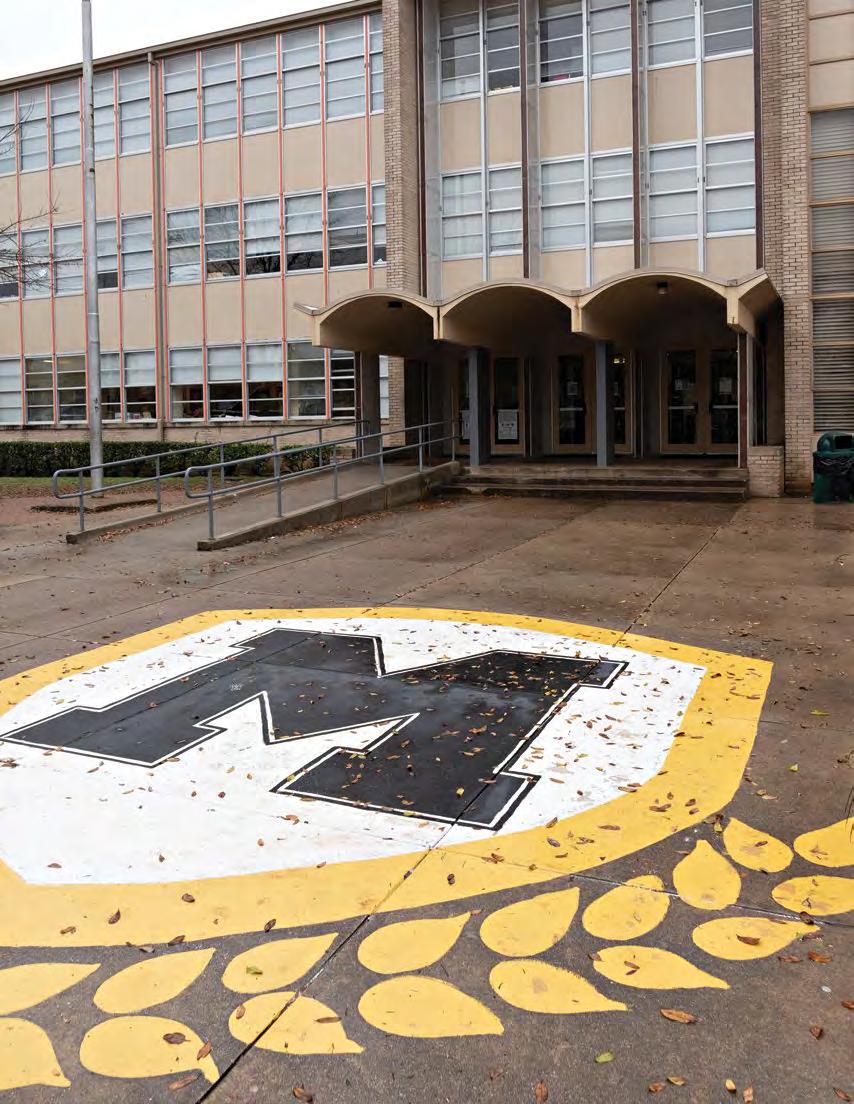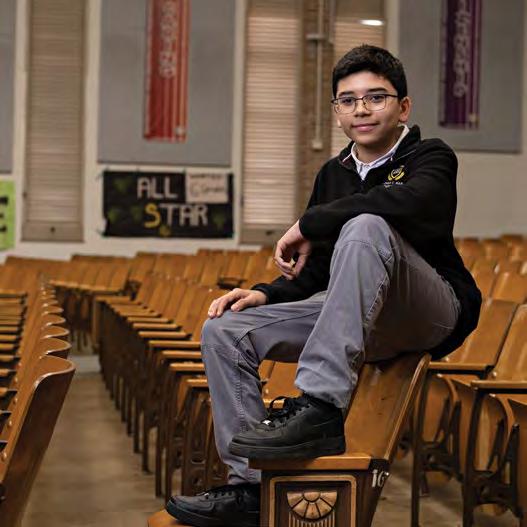
11 minute read
Feature: Networked for Change
Networked for Change
A new initiative from the University of Pittsburgh seeks to transform the lives—and education—of students in the Dallas Independent School District in Texas. Funded by a $7.4 million grant from the Bill & Melinda Gates Foundation, the project is fusing elements of network theory, continuous improvement, improvement science, and equity and justice principles to bolster the capabilities of teachers and boost the learning of minoritized students. If proven effective, the interventions from this project may then be applied in urban schools nationwide.
Written by Greg Latshaw Photographs courtesy of Jeff Dietz, Dallas Independent School District
Juan Araujo is an eighth grader at the Thomas C. Marsh Preparatory Academy in Dallas, Texas. He plays the violin in his school orchestra and is a cadet in the Army Junior ROTC program.
According to him, his English language arts and reading class became a “lot more fun” this school year. That’s because they started reading more books, like the American classic “To Kill a Mockingbird” by Harper Lee, he says.
His class also is incorporating more small group discussions and writing exercises. Recently, Araujo completed an activity inspired by speed dating. With his teacher keeping a stopwatch set at short intervals, he and his classmates moved around the room for conversations with different partners. Instead of starting these chats with an icebreaker, they were instructed to discuss the relationship among racism, injustice, and poverty. He and his classmates drew on texts they had read in class, as well as their own life experiences. “It was really entertaining to see the other person’s different opinion. It was like an argument, we kept taking a side,” says Araujo, age 14.
Like most of his classmates, Araujo is Latino. The middle school he attends is part of the Dallas Independent School District (Dallas ISD), which is one of the largest and most diverse districts in the nation. The district has over 155,000 students and 10,000 teachers. They are in 230 schools spread across over 375 square miles of urban terrain—a geographic area over six times the size of Pittsburgh. Of the total student population, 70% are Latinx, 22% are Black, 5% are White, and less than 2% are Asian.
For the past two years, the district and the University of Pittsburgh have teamed up through the Networks for School Improvement program of the Bill & Melinda Gates Foundation. Starting with students in the eighth and ninth grades, the effort seeks to increase the reading and writing proficiency of students, the vast majority of whom are Black or Latinx. Most students also are from economically disadvantaged households, and many are English language learners. The goal is to raise the students’ literacy proficiency to the level of being prepared to attend college or enter the workforce.
The initiative began with 14 schools from across the Dallas ISD—seven middle schools and the seven high schools that receive students from these middle schools. The decision to focus on eighth- and ninth-grade students was made because this transitional period is a pivotal time for determining a student’s future readiness for college.
“The biggest challenge we face in our district is overcoming generational poverty,” says Michael Hinojosa, the superintendent of the Dallas ISD. “But we’re very excited about this initiative. We know that if students can write, if they can read, if they can communicate, then that will serve them well for the rest of their lives.”
The changes that Araujo experienced in his English language arts and reading class are direct effects of the new Networks for School Improvement initiative. Teachers have embraced it, and the changes are already producing results.





The Dallas/IFL Network for School Improvement is a partnership between the Institute for Learning (IFL), the Learning Research and Development Center (LRDC), and the Center for Urban Education (CUE) at the University of Pittsburgh School of Education. Funded by a five-year, $7.4 million grant from the Gates Foundation, it is one of 30 instances of Gates-funded Networks for School Improvement that are occurring simultaneously in over 20 states.
“At its heart, this is an equity project. We are seeking to improve the education of the most marginalized students in the school system,” says Rosa Apodaca, executive director of IFL and a cluster lead in the project.
“This is about changing the minds and mindsets of how you work with students,” she says. “Giving them access to high-quality work is a mindset change.”
The initiative is grounded in the principles of continuous improvement and improvement science, which are more common in domains like supply chain management or medical science, says Anthony Petrosky, codirector of IFL and a professor in the School of Education. He is the project lead. He became so immersed in the project that he rented an apartment in Dallas so that he could visit the schools daily rather than having to fly in from Pittsburgh. Apodaca and the IFL fellows who are supporting a group of schools in the project, Denise Collier and Glenn Nolly, also are full-time residents of Dallas. Sara DeMartino, the IFL fellow who oversees the monthly network meetings and professional development in Dallas, makes the trip from Pittsburgh two to three times a month.
“The passion for me is because of the kids. I know these kids. I’m not Black or Latinx, so my experience isn’t equivalent, but I grew up in poverty, and I went to schools where I know what it’s like to be given dummied-down work,” says Petrosky.
Network theory is central to the project’s design, says Jennifer Russell, an associate professor at the School of Education and a research scientist at LRDC. The Pitt team acts as a central hub, and the spokes of the wheel are the 14 individual schools. All are connected
School District Snapshot
The Dallas Independent School District is the second-largest school district in Texas and 14thlargest school district in the United States. • Serves over 155,000 students in pre-K through 12th grade • Has 230 schools across a geographic area of 375 square miles • Employs over 20,000 people, including 10,000 teachers • 70% of students are Latinx, 22% of students are Black, and 44% of students are emergent multilingual learners
through opportunities to learn and work together. Time is built into the school day for teachers to lesson-plan around the project’s interventions. There also are regular meetings among teachers, assistant principals, and instructional coaches that provide opportunities for idea sharing and professional development. These meetings are facilitated by IFL fellows. In addition, the project leads also meet regularly with senior leadership at the Dallas ISD.
“Practical measures, such as quick, simple reviews of students’ and teachers’ work, are an important part of these structured networks. The goal is to facilitate improvement in ways that will allow us to finally make traction in problems that otherwise seem intractable in education,” says Russell.
Juan Araujo

Identifying the Necessity of
Instructional Rigor
Based on the tenets of improvement science, the project consists of five phases: analyze the problem, create a theory of improvement, test changes, measure progress, and scale and share progress. The latter phases happen concurrently as investigators and school officials work together to adapt and make improvements on the fly. The Pitt team began the project in the 2018-19 school year with a root cause analysis. This identified which solvable problems were blocking student achievement. The root cause analysis consisted of three primary components. First, the investigators conducted a novel statistical analysis of data sets provided by the Dallas ISD. The data included student attendance, disciplinary actions, enrollment in high-level courses, and scores on standardized tests broken down by race, ethnicity, and gender. Second, educators in Dallas completed hundreds of empathy interviews with students and teachers. These interviews provided firsthand accounts of their experiences
with reading and writing. Third, the investigators performed an “asset walk” to assess existing strengths within the Dallas ISD. Among virtues that were identified were the boundless curiosity of students and the positive relationships between teachers and students.
The root cause analysis came to a clear conclusion. The students’ subpar achievement levels in reading and writing were due, more than anything else, to a lack of rigorous instruction. It wasn’t that students weren’t motivated. It wasn’t that they didn’t care. The truth was that they weren’t being challenged enough. Furthermore, the teachers wanted to support them but didn’t feel prepared or have the tools for high-quality instruction. Teachers also felt a tension in needing to prepare students for the state tests, which narrowed their instructional approach. Making matters worse, many of these teachers were young and inexperienced, which is a problem faced by urban school districts nationwide.
“This is an issue of equity,” says Petrosky. “Both teachers and students were frustrated by the limited instruction they were receiving in writing. Students want to write about the things they care about and not just be focused on the test. Teachers want to teach that way but feel like they don’t know how to balance it with preparing students for the state test.”
To ensure that students and teachers have a voice, the research team includes Dana Thompson Dorsey, an associate professor in the School of Education and associate director for research and development at CUE. She ensures that equity is infused into classroom instruction across every stage of the project. Bolstering the capabilities of teachers involves learning about equity and justice principles, including antibias and antiracist work, as well as culturally responsive education.
Nationwide, students of color are targets for prejudice in the classroom, which is rooted in the racial history of the United States, says Thompson Dorsey. Despite the fact that racial segregation was outlawed in schools over 65 years ago, inner-city schools are becoming increasingly Black and Brown as the families of White students continue to move to more affluent school districts. These inner-city schools are losing funding as the school choice movement directs more money away from public schools. Furthermore, inner-city schools frequently have the least experienced and most overworked teachers and disproportionately high disciplinary rates for students of color. Thompson Dorsey says that, in this environment, it is hard enough for students to survive, let alone thrive.
“We hope this project will help to address some of the educational inequities and racial biases that are deeply ingrained in the larger society,” says Thompson Dorsey. “It’s easy to blame students and families for why the test scores are low. Those are the same biases that are always part of the education system, to blame them rather than looking at the effects of the larger systems.”
Enacting Tests of Change in the
Classroom
During this past school year, the Pitt team and Dallas ISD administrators began implementing tests of change to address problems of practice. If these interventions are successful, they can then be scaled up from the 14 pilot schools to implementation districtwide. One major effort already paying dividends is the district-wide curriculum redesign for reading and language arts in grades three through 12. The district has shifted its focus to “high-complexity and engaging texts,” with a special emphasis on materials that are culturally relevant, says Pablo Singh, the teaching and learning manager of language, literacy, and social studies in the
Dallas ISD. “Previously, our curriculum was very teacher centered.
But we’re now focused more on pushing student thinking and making things more student centered,” says Singh.
There also are smaller tests of change that are having a big impact. Frank Jackson
Student-facing task sheets, developed by the teachers, were introduced in the classroom. The task sheets contain a purpose statement and sequenced, targeted instructions for the lesson.
“The task sheets help teachers to build their pedagogical knowledge by helping them to forecast their lessons.
Small Tests Of Change
Year one of the project was focused on identifying the root causes of the problem. This past year has been focused on tests of change to solve the problems. • Task Sheets: Clear set of instructions developed by the teacher and followed by the student • Quick Writes: Writing exercise that help students to develop an imperfect first draft and organize their thoughts • Gallery Walks: Discussion exercise in which students post thoughts on the wall and then walk the room to read what others have said • Pair and Trio Discussions:
Focused small group discussions where each person must share their thoughts
They also make the students own their work,” says Erika Prelow-Stephens, an instructional lead coach who oversees the coaches who train teachers at Dallas ISD.
At Justin F. Kimball High School, ninth-grade teachers Frank Jackson and Jada Weathers both regularly use task sheets to organize their lessons. Jackson, who is part of the Teach For America program, is originally from the Philadelphia area. He recalls using a task sheet to guide a lesson that included a discussion on the U.S. Immigration and Customs Enforcement’s increased enforcement activity in communities in Dallas. “It was a good discussion that day. That’s how I remember learning—by talking with one another” says Jackson. “This has allowed my students to be more expressive. My students struggle with sharing their own thoughts and ideas. They are so used to testing and multiple choice.”
The initiative has introduced additional new tools to stimulate students’ engagement with each other around critical thinking and analysis.








